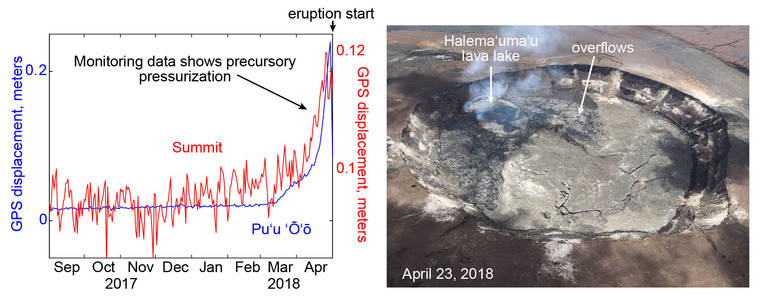Increasing magma pressure most likely culprit in triggering the 2018 Kilauea eruption

Plot of ground motion as recorded by a GPS station at Kilauea’s summit (red) and the Puu Oo vent (blue) for the 8 months leading up to the 2018 eruption. Note the sharp increase indicating pressurization beginning in March. Image shows an aerial view of Halemaumau crater and the actively overflowing lava lake on April 23, 2018. (USGS Photo/Courtesy)
Understanding the immediate causes of volcanic eruptions is necessary for timely warnings. The topic, therefore, is of great interest to volcanologists, and each eruption offers an opportunity to add insight.
Understanding the immediate causes of volcanic eruptions is necessary for timely warnings. The topic, therefore, is of great interest to volcanologists, and each eruption offers an opportunity to add insight.
This week, many of us read news coverage of a recent study suggesting that unusually heavy rainfall triggered the 2018 eruption of Kilauea. To address possible heightened concern about this correlation, this week’s Volcano Watch offers comments based on HVO’s collective scientific understanding of Kilauea. Meanwhile, HVO and USGS colleagues are preparing a formal response for publication in the scientific literature.
This hypothesis about heavy rainfall is thought-provoking, but does it mean that Hawaii residents need to be concerned that heavy rain might cause the next eruption?
Based on HVO’s analysis of data collected in 2018, plus many studies of previous eruptions, our answer is that no, residents need not be concerned about a connection.
Our analysis indicates that increasing pressure in the magmatic system, which far exceeds the change in pressure modeled as due to rainwater infiltration, was the primary driver in triggering the 2018 eruption.
For HVO, the smoking gun is found in the ground deformation record across a broad region of Kilauea Volcano leading up to the eruption.
Specifically, tiltmeter and GPS stations recorded rapid uplift of the ground surface, best explained as the result of increasing pressure within the magmatic plumbing system at Puu Oo, starting in March 2018. Rapid uplift began at the summit of Kilauea a few weeks later as the summit reservoir began inflating. This pressurization was widespread and drove lava lakes at Puu Oo and the summit to unusually high levels, causing the largest overflows in Halemaumau during the entire 10-year lifespan of the lava lake.
These changes were so clear that HVO issued a Volcano Activity Notice on April 17, 2018, noting ongoing pressurization, and forecasting that a new eruptive vent could form on the East Rift Zone.
On April 30, there was a small outbreak of lava on the flank of Puu Oo. Magma then drained from within the shallow Puu Oo system, the summit of Puu Oo collapsed, and magma moved forcefully down the core of the rift zone toward Leilani Estates. This intrusion continued for several days, driven by magmatic pressure within the rift zone, ultimately erupting on May 3.
In summary, our consensus interpretation of HVO’s monitoring data is that magma pressurization was the driving force in triggering the events of late April and early May of 2018.
No external process, such as rainfall, is needed to explain this.
But what about the rainfall hypothesis? While the role of groundwater and rain infiltration impacting the behavior of the volcano remains an interesting area of research, we know that extreme rainfall events have occurred many times in the recent past when no eruptions occurred, and the spring 2018 rains were no greater than many previous rainstorms.
Science demands that one pose a question, gather observations, develop a hypothesis, and test the idea against available data and models. It is not uncommon for scientists to have conflicting ideas about the interpretation of data. In fact, vigorous debate over interpretations and the validity of conclusions is the hallmark of the scientific process, an expected part of the scientific method and search for the truth.
Kilauea’s 2018 eruption was remarkable and, sadly, very destructive, but the cause seems to have followed the pattern of many previous eruptions – rising magma pressure reached a critical threshold, and magma could no longer be contained. And, while the complexity of Kilauea’s magma system makes predicting the timing and size of eruptions difficult, understanding the signs and effects of changing magmatic pressure is the most promising avenue toward forecasting future events.
Volcano Watch (https://volcanoes.usgs.gov/hvo/hvo_volcano_watch.html) is a weekly article and activity update written by U.S. Geological Survey Hawaiian Volcano Observatory scientists and affiliates.
Volcano Activity Updates
Kilauea Volcano is not erupting. Its USGS Volcano Alert level remains at NORMAL (https://volcanoes.usgs.gov/vhp/about_alerts.html). Kilauea updates are issued monthly. Kilauea monitoring data over the past month showed no significant changes in seismicity, sulfur dioxide emission rates, or deformation.
The water lake at the bottom of Halema‘uma‘u continued to slowly expand and deepen. For the most current information regarding the depth of the lake see https://volcanoes.usgs.gov/volcanoes/kilauea/summit_water_resources.html
Mauna Loa is not erupting. Its USGS Volcano Alert level remains at ADVISORY. This alert level does not mean that an eruption is imminent or that progression to an eruption from the current level of unrest is certain. Mauna Loa updates are issued weekly.
During the past week, HVO seismometers recorded 78 small-magnitude earthquakes on the volcano’s summit and upper-elevation flanks of Mauna Loa. Most of these earthquakes occurred at shallow depths of less than 8 kilometers (~5 miles) below ground level. The largest earthquake was a magnitude 2.3 under the south caldera. Global Positioning System (GPS) measurements show continued slow summit inflation, consistent with magma supply to the volcano’s shallow storage system. Gas concentrations at the Sulphur Cone monitoring site on the Southwest Rift Zone remain stable. Fumarole temperatures as measured at both Sulphur Cone and the summit have not changed significantly.
For more information on current monitoring of Mauna Loa Volcano, see: https://volcanoes.usgs.gov/volcanoes/mauna_loa/monitoring_summary.html
HVO continues to closely monitor both Kilauea and Mauna Loa.
Please visit HVO’s website (https://volcanoes.usgs.gov/hvo) for past Volcano Watch articles, Kilauea and Mauna Loa updates, volcano photos, maps, recent earthquake info, and more. Email questions to askHVO@usgs.gov.


